The 2018-19 Nashville Predators are a good hockey team. That’s no surprise, they were supposed to be. They also got better at the 2019 Trade Deadline as general manager David Poile brought in Bryan Boyle, Mikael Granlund and Wayne Simmonds.
But there’s one area that has been problematic for the team all season: the power play. That won’t come as a shock to Predators fans who’ve watched this team struggle on the man advantage all season. The Predators are a great five-on-five team, yet they have failed to be consistently effective on the power play, currently sitting 30th in the league.
So that raises the question: can this team, which has Stanley Cup aspirations, make a deep playoff run despite a poor power play? That’s a question I’m going to attempt to answer, but it starts with a deep dive into the 2018-19 Predators’ power play.
Predators’ Power Play in 2018-19
As mentioned above, the Predators’ power play ranks 30th in the league. They have converted at a 12.4 percent clip with 28 goals on 226 opportunities. Their 28 goals on the man advantage tie for third-fewest in the league.
They’ve played 23 games in which they’ve scored at least one power-play goal, which is second-fewest in the league. They’ve gone 16-6-1 in those games. They’ve also had five games in which they’ve scored multiple goals on the man advantage, 23rd-most, and have a 2-2-1 record in those games. They have power-play goals in consecutive games eight times this season, but not since Jan. 7 and 9. They also went nine games without a goal on the man advantage between Jan. 10 and Feb. 2.
On the man advantage, the five most-used Predators in terms of power-play ice time this season are Roman Josi (two goals, 11 points), Ryan Johansen (14 points, all assists), Filip Forsberg (five goals, eight points), Ryan Ellis (one goal, five points) and Craig Smith (four goals, seven points).

Their 13 players with at least one power-play goal this season are tied for second in the league and their seven with multiple power-play goals are tied for 17th. In total, the Predators have 15 players with at least one point on the man advantage and 12 with multiple power-play points.
Broken down into per-60 minutes stats, the Predators continue to rank poorly on the power play. Their 4.3 goals for per-60 minutes (GF/60) are 31st, their 44.4 scoring chances per-60 (SCF/60) are 24th and their 16.7 high-danger chances per-60 (HDCF/60) are 28th. They also have the league’s worst shooting percentage on the power play at 8.8 percent.
So now that we know how the Predators’ power play has performed this season, how do they compare with the power plays of teams that have had success in recent seasons?
Comparing the 2018-19 Predators to Past Five Stanley Cup Winners
To answer that question, I’m going to look at the past five Stanley Cup winners and see how the Predators compare to them. I’ll look at the teams’ rate stats, where they ranked and who their top performers were. I will also look at how their power play performed in the postseason en route to a Stanley Cup. First up are the 2017-18 Washington Capitals.
2017-18 Washington Capitals
In 2018, the Capitals won their franchise’s first Stanley Cup, bringing to an end decades of futility. With names like Alexander Ovechkin, Nicklas Bäckström, Evgeny Kuznetsov, John Carlson and T.J. Oshie, they were loaded with top-end talent. So it’s not surprising that they had the league’s seventh-best power play during the regular season at 22.5 percent.
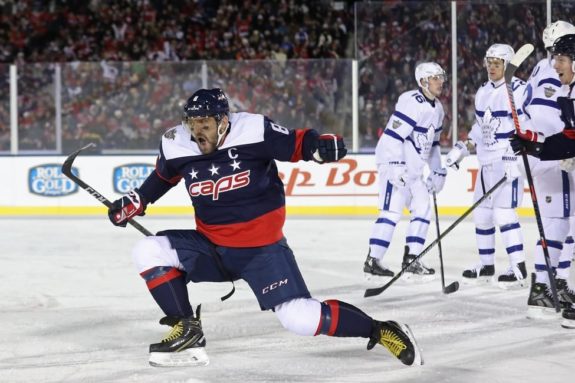
On the power play, the Capitals scored 8.32 GF/60, seventh-most, and generated 43.9 SCF/60, 26th in the league, and 17.1 HDCF/60, 28th in the league. This is interesting because it means that they scored a large number of goals relative to the amount of chances they created. That is due to them shooting 14.6 percent on the man advantage when they shot 10.7 percent in all situations in the regular season. This is, again, unsurprising as Ovechkin has victimized penalty killers throughout his career and has shot at least 15 percent on the power play in seven of his 12 seasons, including 2018-19.
The five players listed above also happened to be the five Capitals with the most power-play time during the 2017-18 regular season. All five came through in a big way on the man advantage. Carlson had four goals and 32 points on the man advantage, Ovechkin had 17 goals and 31 points, Kuznetsov had seven goals and 30 points, Bäckström had seven goals and 26 points and Oshie had nine goals and 18 points.
In the postseason, the Capitals’ power play was even better at 29.3 percent. They scored 22 goals on 75 opportunities.
As would be expected, the Predators’ power play doesn’t compare to the Capitals’ unit. Between the two teams, the Capitals have the higher goals for per-60 and high-danger chances per-60. They also have the higher shooting percentage (14.6 to 8.8). But that’s not surprising as the Predators don’t have anyone on their roster with the goal-scoring ability that Ovechkin possesses.
| GF/60 | SCF/60 | HDCF/60 | |
| 2017-18 Capitals |
8.32 |
43.9 | 17.1 |
| 2018-19 Predators | 4.36 | 44.4 |
16.7 |
2016-17 Pittsburgh Penguins
In 2017, the Penguins became a modern-day dynasty when they won their second of back-to-back Stanley Cups. If the 2015-16 Penguins rode a balanced approach to a Stanley Cup, the 2016-17 team was all offense. Their special teams reflected this with a power play that converted at a 23.1 percent clip, third-best in the league.
As would be expected from a team that featured future Hall of Famers Sidney Crosby and Evgeni Malkin, plus Kris Letang and Phil Kessel, the 2016-17 Penguins were dynamic at generating and converting on power-play chances. Their 8.46 GF/60 ranked fourth, their 58.7 SCF/60 ranked third and their 23.7 HDCF/60 were sixth.
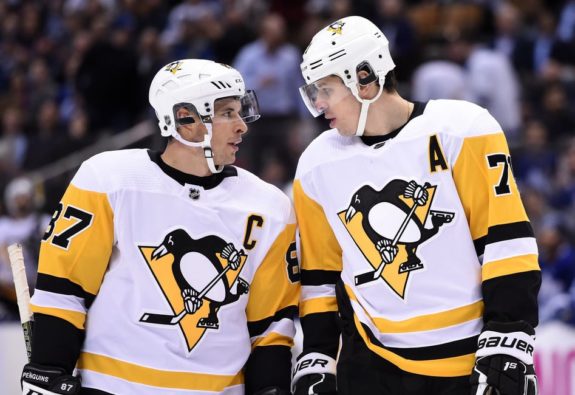
Crosby, Kessel and Malkin were among the five Penguins who received the most power-play time during the regular season. In addition to those three, were Patric Hornqvist and Justin Schultz. Letang, typically an anchor on Pittsburgh’s power play, only played in 41 regular-season games in 2016-17 and sat out the entire postseason due to a herniated disc in his neck. Kessel paved the way with eight goals and 30 points on the man advantage. Following him, Crosby had 14 goals and 25 points, Malkin had 11 goals and 23 points, Schultz had three goals and 20 points and Hornqvist had 10 goals and 17 points.
In the playoffs, the Penguins’ power play clicked at 20.5 percent by way of 16 goals on 78 opportunities.
The 2016-17 Penguins had one of the more talented power plays in recent memory so it’s no surprise that it was better than this season’s Predators. Between the two teams, the Penguins have the better rate stats in all three areas.
| GF/60 | SCF/60 | HDCF/60 | |
| 2016-17 Penguins |
8.46 |
58.7 | 23.7 |
| 2018-19 Predators | 4.36 | 44.4 |
16.7 |
2015-16 Pittsburgh Penguins
Entering the 2015-16 season, six seasons had passed since the Penguins won their most recent Stanley Cup in 2009. With that first Cup, in Crosby’s fourth season, it looked like the team had a chance to go on a run of dominance over the next decade or so. However, while they experienced great regular-season success and reached the playoffs every season, they were unable to get out of the Eastern Conference. So, when the 2015-16 season began, it’s safe to say that few Penguins fans felt overly optimistic.
As mentioned above, the 2015-16 Penguins were a well-balanced team. Their power play ranked 17th at 18.4 percent. On the power play, they averaged 6.57 GF/60, 16th in the league, 53.0 SCF/60, seventh, and 19.6 HDCF/60, 13th.
Like the season that followed, Crosby, Hornqvist, Kessel and Malkin were four the Predators’ most-used players on the man advantage. In 2015-16, however, Letang was mostly healthy and rounded out the top-five. Letang and Malkin tied for the team-lead in power-play points with 27, Letang by way of five goals and 22 assists and Malkin with 11 goals and 16 assists. Additionally, Crosby had 10 goals and 24 points, Kessel had four goals and 17 points and Hornqvist had nine goals and 15 points.
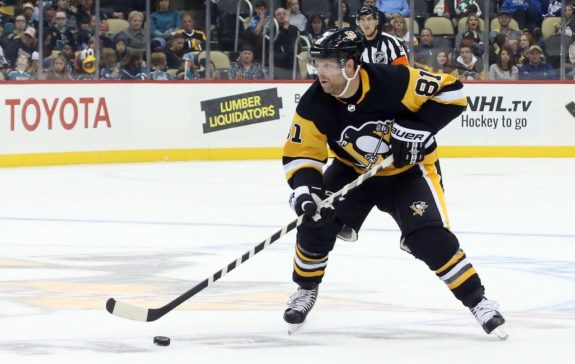
Once the postseason began, their power play succeeded at a higher rate. They converted on 18 of 77 chances, or 23.4 percent.
The 2015-16 Penguins were a better team than this season’s Predators in pretty much every area. The Penguins have the advantage in every power play rate stat.
| GF/60 | SCF/60 | HDCF/60 | |
| 2015-16 Penguins |
6.57 |
53.0 | 19.6 |
| 2018-19 Predators | 4.36 | 44.4 |
16.7 |
2014-15 Chicago Blackhawks
The 2014-15 Blackhawks were the most-recent installment of their modern-day dynasty that began in 2010. They were also a team predicated on balance when it came to the power play. That’s understandable as Jonathan Toews, Patrick Kane, Duncan Keith and Marian Hossa will all be enshrined in the Hockey Hall of Fame one day. And it doesn’t include Patrick Sharp, Brandon Saad or Brent Seabrook, all who played big roles.
Despite all that talent, that season’s Blackhawks only ranked 19th on the power play at 17.7 percent. Their 6.18 GF/60 tied for 19th, their 44.7 SCF/60 ranked 23rd and their 17.5 HDCF/60 were 22nd. Toews, Keith, Kane, Hossa and Andrew Shaw were the five most-used players on the power play. Kane paced the team in power-play scoring with six goals and 22 points. He was followed by Toews and Hossa’s six goals and 17 points, Keith’s three goals and 16 points and Shaw’s five goals and six points.
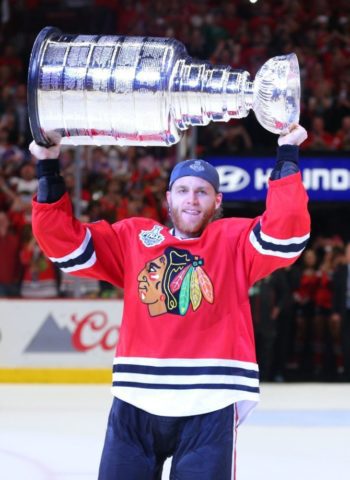
In the postseason, their power play improved ever so slightly to 17.9 percent after scoring 12 goals on 67 opportunities.
From a roster composition standpoint, the 2014-15 Blackhawks and the 2018-19 Predators are fairly comparable. Forsberg and Johansen are lower-impact versions of Kane and Toews, newly-acquired Simmonds can play the net-front role that Shaw did with Chicago, Viktor Arvidsson is a goal scorer who still plays a sound two-way game like Hossa did and the Predators’ defense is better than the Blackhawks’ was.
However, when looking at the two teams’ specials teams from a rate standpoint, the Blackhawks blow the Predators away. They have the better power play numbers in all three areas.
| GF/60 | SCF/60 | HDCF/60 | |
| 2014-15 Blackhawks |
6.18 |
44.7 | 17.5 |
| 2018-19 Predators | 4.36 | 44.4 |
16.7 |
2013-14 Los Angeles Kings
The third team to win multiple Stanley Cups in the 2010s (so far), the Kings captured their second Cup in three seasons in 2014. As was their calling card under the leadership of former head coach Darryl Sutter, the 2013-14 Kings struggled offensively but excelled at shutting down the opposition. This was evident with their 26th-ranked offense and first-placed defense.
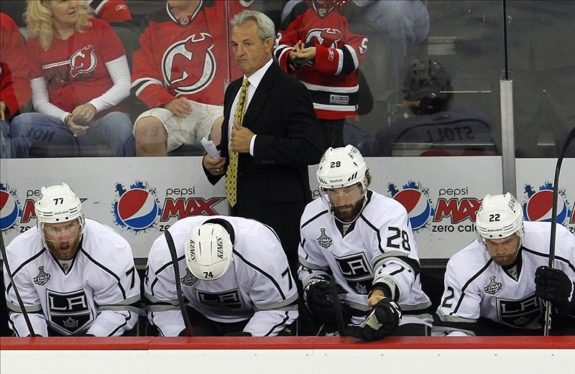
Their power play was representative of their struggling offense as it ranked 27th at 15.1 percent. Their 5.28 GF/60 ranked 28th, their 49.6 SCF/60 ranked eighth and their 22.0 HDCF/60 ranked ninth. Their five most-deployed players on the power play included two defensemen, Drew Doughty and Slava Voynov, and three forwards, Anze Kopitar, Jeff Carter and Mike Richards. Kopitar had 10 goals and 23 points, Doughty had six goals and 16 points, Carter had eight goals and 14 points, Voynov had one goal and 13 points and Richards had four goals and 12 points.
In the postseason, their power play improved to the tune of 23.5 percent with 20 goals on 85 chances.
It appears as though the Predators line-up well with the Kings, on the surface. Their offensive firepower matches what the Kings had and their defense is better top-to-bottom. The biggest sticking point is in net where Jonathan Quick has created a name for himself as a big-game performer. By per-60 stats, the Kings have the better power play in all categories.
| GF/60 | SCF/60 | HDCF/60 | |
|
2013-14 Kings |
5.22 | 49.6 | 22.0 |
| 2018-19 Predators | 4.36 | 44.4 |
16.7 |
Is the 2018-19 Predators’ Power Play Good Enough?
So, after looking at the 2018-19 Predators’ power play and comparing it to the past five Stanley Cup winners, what did we learn? In general, the Predators’ struggles on the power play don’t bode well for them in the near future. Their per-60 rates are worse in all but one category across all five teams that I compared them to, with the lone exception being scoring chances per-60 when compared to the Capitals.
While the majority of hockey games are played at five-on-five, where the Predators are a good team, most Stanley Cup winners possess quality power plays. In fact, the last Cup winner whose power play was ranked second-last or worse were the 2002-03 New Jersey Devils, with a league-worst 11.9 percent. The difference between they and this season’s Predators was the Devils had a goaltender named Martin Brodeur. Pekka Rinne and Juuse Saros are good, but neither are Brodeur.
Is There Reason for Hope?
For starters, fans should be able to find hope in the Predators’ power-play shooting percentage rebounding. However, because the Predators have now played 68 games, it’s unlikely their shooting percentage rebounds much from the 8.8 percent it’s currently at.
Last season, they shot 15 percent on the man advantage, which was sixth-highest in the league. As a result, their power play succeeded at a 21.2 percent clip, 13th in the league. Considering that their scoring chances and high-danger chances per-60 from 2017-18 were similar to this season’s numbers while their goals for per-60 last season were almost double this season’s rate, the regression in shooting percentage is the main culprit of their power-play woes.
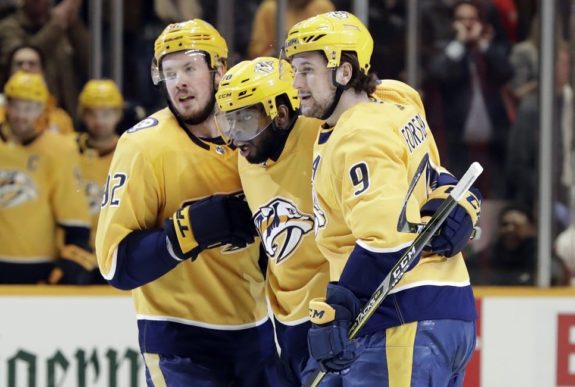
And, looking at individual players’ shooting percentages, it’s clear why the team’s shooting percentage has regressed. Of the 10 players who’ve played at least 100 minutes on the power play this season (excluding Kevin Fiala), eight have had their shooting percentages regress relative to 2017-18. The two outliers are Nick Bonino, who shot zero percent last season but is shooting 15.8 percent this season, and Kyle Turris, who shot 25 percent in 2017-18 but is shooting 36.4 percent in 2018-19.
Such a widespread shooting outage makes it difficult to believe in a rebound, and therefore difficult to expect the power play to be more successful throughout the remainder of the regular season and into the playoffs. Now part of the regression in shooting percentage could be the result of where the Predators attempt their shots from. Because the power play runs through the defensemen, the Predators often shoot from distance. That’s not a recipe that leads to high shooting percentages.
If location is the problem, it’s something that could change between now and the postseason. Changing up the power-play setup and who’s deployed can have a big impact. The additions of Boyle, Granlund and Simmonds have already made a difference as head coach Peter Laviolette has gone with a four forwards, one defenseman setup on both power plays as opposed to the three forwards and two defensemen he used before the trade deadline.
With Boyle and Simmonds as net-front presences and Granlund working the halfway, the Predators have been more of a threat on the man advantage in recent games. Couple that with generating more high-danger chances in general since the trade deadline and the fact that P.K. Subban has been heating up, and the power play could be turning the corner.
The fact that both Granlund and Simmonds have tallied points since being acquired bodes well moving forward. The more chemistry they develop with teammates, the more likely it is that the power play converts at a higher clip. Had the Predators not acquired Granlund and Simmonds, two top-six forwards, I would have said that there wasn’t hope for the power play to turn around, and by default, little hope for the team to make a deep run in the postseason because having a productive power play is a key to winning the Stanley Cup (unless you have Brodeur).
However, since the Predators do have Granlund and Simmonds, and both are talented and hungry players, I think there is reason to believe that the power play turns things around. Momentum can be a weapon come playoff-time and many teams have ridden hot streaks to the Cup Final, including the 2016-17 Predators. Because of that, I think there is still reason to believe that this team can make a deep playoff run.
*All stats came from Hockey-Reference and Natural Stat Trick